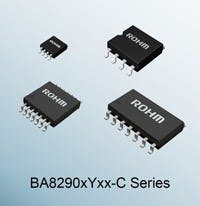Rohm Introduces High EMI Tolerance Op Amps
As automotive systems digitize more functions to make greater use of the ECUs and sensors on board, there has been a concomitant increase in the amount of noise generated—presenting design issues for engineers specifying small signal devices. Too often this noise presents itself only after system installation and cannot be predicted in simulation, resulting in expensive post-production modifications. Devices and systems have been known to malfunction when EMI noise is present if steps are not taken to reduce or counteract it.
This week Rohm introduced what it claims is the first family of op amps that eliminate the effects of noise in automotive sensors. The company is keeping close to the vest on exactly how it achieves this goal, saying only that it was achieved by means of “a thorough review of all circuits, layout, and processes,” including the utilization of a vertically integrated production system that “leverages analog design technology and noise countermeasures” applied in circuit design and layout and “during the bipolar process.” The noise immunity achieved limits output voltage fluctuation to less than ±1%, as opposed to ±3.5% to 10% typical with conventional op amps, according to the company. As a result the number of filters needed is cut by 3 (CR filters for the input/output power supply), reducing design complexity and resulting in higher system reliability.
BA82904YF-C BA82904Yxxx-C, and BA82902Yxx-C are high-gain, ground sense input op amps that integrate dual or quad independent op amps on a single chip. These op amps can operate from 3V to 36V (single power supply); BA82904Yxxx-C and BA82902Yxx-C are manufactured for automotive applications such as the engine control unit (ECU) and electric power steering subsystem. Other applications include electric vehicle (EV) inverters, EV chargers, and HID headlamps.
The lineup is AEC-Q100 qualified and delivers current consumption of 0.5mA (two-channel) to 0.7mA (four-channel), and input offset voltage of ±2mV (typical) against ±6 mV (maximum). Typical package types are available (SOP8, MSOP8, SOP14, SSOP-B14).


